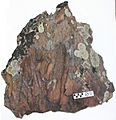Beaverhead crater facts for kids
| Impact crater/structure | |
|---|---|
| Confidence | confirmed |
| Diameter | 60 kilometres (37 mi) |
| Age | 600 million years |
| Exposed | Yes |
| Drilled | No |
| Location | |
| Coordinates | 44°36′N 113°0′W / 44.600°N 113.000°W |
| Country | United States |
| State | Idaho, Montana |
The Beaverhead crater is a huge impact structure. This means it's a place where a giant space rock crashed into Earth. It stretches across parts of Idaho and Montana in the United States.
Scientists believe this crater is about 60 kilometers (37 miles) wide. This makes it one of the largest impact craters ever found on our planet.
Contents
What is the Beaverhead Crater?
The Beaverhead crater is not easy to see today. It formed a very, very long time ago. Over millions of years, rocks and soil have covered most of it. But scientists have found clues that prove it's there.
How Old is This Giant Crater?
The Beaverhead impact happened around 600 million years ago. This was during a time called the Neoproterozoic Era. To give you an idea, dinosaurs didn't even exist yet! Earth looked very different back then.
Finding Clues: Shatter Cones
One of the main clues that scientists found are special rocks called shatter cones. These cones are shaped like parts of a cone or carrot. They only form when a very powerful shockwave hits rocks. This kind of shockwave happens during a massive impact event.
- Shatter cones are often found pointing towards the center of the impact.
- They are a strong sign that a meteor or asteroid hit the area.
- The shatter cones around the Beaverhead crater's edges are some of the only visible signs left.
Where Did the Name Come From?
The crater is named after the Beaverhead region. This area is in southwestern Montana. It's where the first signs of this ancient impact were discovered.
Images for kids



